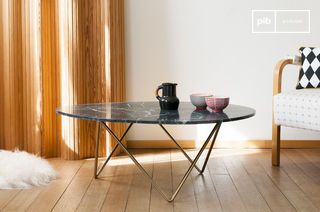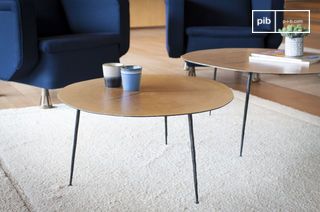Organic coffee tables
Organic coffee tables introduce free forms into compositions often marked by straight lines. An organic coffee table bypasses the symmetrical codes of low furniture by adopting curved tops, irregular contours or asymmetrical volumes. These pieces create a smooth transition between elements, with no visual break. They blend into open environments or living rooms where fluidity takes precedence over alignment. The choice of materials - wood, stone or resin - often accompanies this logic of natural curves. Installation is designed in relation to open space rather than a central axis.
read more >Filters

Green marble coffee tableTrivisan
€595 €535-10%

Round metal coffee table OneXylème
€495 €445-10%

"Round metal coffee table ""Two"""Xylème
€495 €445-10%

The organic coffee table as a point of visual articulation
An organic coffee table introduces an irregular, continuous, non-symmetrical form into the center of the living room. It's distinguished by a free-form layout of the top, often inspired by natural silhouettes: pebble, leaf, mineral formation. Unlike geometric models, it is not based on right angles or standardized proportions. This feature allows the dynamics of a space to be modified by eliminating dominant axes and directional breaks.
Rather than strictly structuring space, it accompanies it. Its placement doesn't necessarily follow the exact center of a rug or the alignment of a sofa, but can be offset, refocused on a circulation point or turned towards a view. It acts as a link between several zones: seating, low storage, circulation. Its irregular layout makes the perception of the piece of furniture evolve according to the angle from which it is viewed.
Formats, use and circulation
The format of an organic coffee table varies in length, width and curvature, but generally remains contained to maintain good legibility in the room. A length of between 80 and 120 cm allows for a marked presence without occupying the entire living area. Width evolves according to the shape chosen: some areas of the tabletop can be narrower, others wider, to suit the use or position of the seats.
This typology allows flexible arrangement of objects. Books, vases, trays or decorative elements are distributed according to zones of visual stability. The curve can create a natural hierarchical effect without the need for markings. This type of furniture also allows freer interaction: several people can use it simultaneously from different points without facing each other directly, which changes the dynamic of a moment of sharing.
Circulation is facilitated by the absence of sharp edges. The user moves around the table without angular adjustment, favoring integration in small spaces or in multi-flow configurations. In a flow-through or open-plan living room, the organic coffee table acts as a central landmark without blocking reading or mobility.
Materials, structure and perception of volumes
The materials most commonly used for tops are solid or veneered wood, natural stone (travertine, marble), mineral resins and certain textured composites. Wood is ideal for smoothing out curves while retaining a tactile feel. Edges can be straight or smoothed, depending on the type of grain and finish. Stone or ceramic reinforce the mineral aspect. These heavier materials are often combined with a slender or faded base to give way to the mass of the top. Metal or curved wood structures are chosen to follow or contrast the shape of the top. A central base frees up floor space, while distributed multiple legs hug the curves of the edge.
The final rendering also depends on the surface finish. A matte table absorbs light and enhances the shape; a slightly satin surface accentuates the reading of curves without creating excessive reflections. Heights vary from 30 to 40 cm, depending on the model, to match the seating in the living room. Some versions are also available as a duo or as a stackable composition to introduce a variation in scale.
An organic coffee table helps to enliven space without resorting to excessive contrasts. It's based on a soft yet legible form, capable of structuring the room without freezing it. It works particularly well in visually calm environments, but can also be used to balance a very orthogonal composition. Its interest lies as much in its function as in its ability to subtly alter the reading of space.